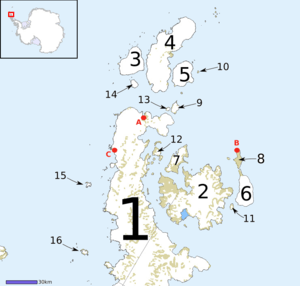Dundee Island
Dundee Island is an ice-covered island lying east of the northeastern tip of Antarctic Peninsula and south of Joinville Island.[1]
 Map of Graham Land, showing Dundee Island (5) | |
 Dundee Island Location in Antarctica | |
| Geography | |
|---|---|
| Location | Antarctica |
| Coordinates | 63°30′S 55°55′W |
| Archipelago | Joinville Island group |
| Administration | |
| Administered under the Antarctic Treaty System | |
| Demographics | |
| Population | Uninhabited |
On January 8, 1893, during the Dundee Antarctic Whaling Expedition, the island was named by Captain Thomas Robertson of the Active and named for their home in Dundee, Scotland. The expedition was made up of three other vessels in an unsuccessful search for commercial whales.[1]
It is from this island that the American businessman Lincoln Ellsworth, accompanied by the pilot Herbert Hollick-Kenyon, took off on the 23 November 1935 for the first crossing of the Antarctic by plane.
Nearby features
The Eden Rocks, a designated Important Bird Area, lie off the east coast of Dundee Island.[2] East past those are another rock, called Puget Rock. The use of "Puget" in this area commemorates Captain William D. Puget of the British Royal Navy. It was first used by Sir James Clark Ross on December 30, 1842, as "Cape Puget", but it is not clear from Ross' text what feature he was naming. The name Puget Rock was chosen by the United Kingdom Antarctic Place-Names Committee (UK-APC) in 1956 in order to preserve Ross' naming choice in the vicinity.[3]
See also
- Composite Antarctic Gazetteer
- List of Antarctic islands south of 60° S
- SCAR
- Territorial claims in Antarctica
- Active Reef
References
- "Dundee Island". Geographic Names Information System. United States Geological Survey. Retrieved 2013-12-03.
- "Eden Rocks". Geographic Names Information System. United States Geological Survey. Retrieved 2018-08-14.
- "Puget Rock". Geographic Names Information System. United States Geological Survey. Retrieved 2018-08-14.
![]()